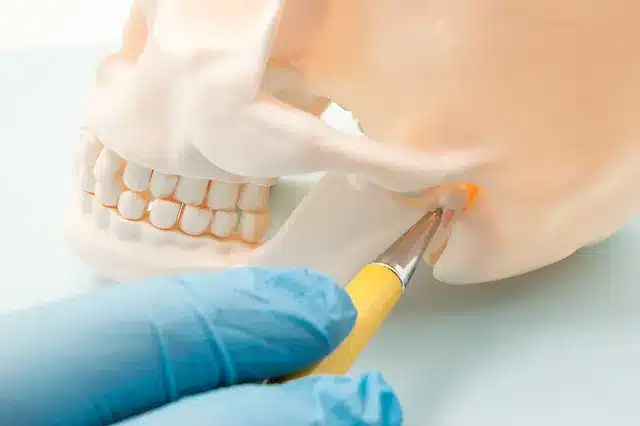Jaw Fracture Treatment
Accidents can occur unexpectedly, whether it’s a slip on a slippery sidewalk, a car accident, or a sports injury. In the event of an accident causing trauma to your jaw, one possible consequence is a fractured mandible, which is the lower jaw.
By identifying the symptoms and obtaining an accurate diagnosis, you can effectively address a mandibular fracture. This is certainly good news because you want the sole movable bone in your head to work properly, enabling you to eat, speak, sing, cheer, smile, and, in essence, savor life.
In Dental Seva, our oral and maxillofacial surgical sections also have expertise in the treatment of jaw fractures using recent advances and attentive care, aiming at the best outcomes for our patients.

Symptoms of Mandibular Fractures
A fractured lower jaw can be intensely painful, especially when attempting to move it in various directions, such as back and forth or up and down. You may find it challenging to either close your mouth or open it wide. If you’ve suffered a jaw fracture, you might also observe the following:
- Bleeding from your nose or mouth.
- Bruising on your jaw or cheek.
- Swelling in your jaw or cheek area.
- Teeth that are chipped or loose, or a misalignment between the upper and lower teeth when closing your mouth.
- Difficulty breathing.
- Pain when trying to chew food or speak.
- Limited ability to open or close your mouth.
- Ear discomfort.
- Numbness in your face, particularly in the lower lip region.
What does Broken jaw look like?
If you have a fractured jaw, you might observe the following indications:
- A noticeable lump on your jaw or cheek.
- Swelling
- Bruising.
How is a broken jaw diagnosed?
A medical professional will inquire about the cause of your jaw injury and perform a gentle examination. Additionally, they will request imaging studies, which may include:
- X-rays.
- Computed tomography (CT) scans to assess potential fractures in other facial bones or internal bleeding.
What’s the treatment for a broken jaw?
The management of a jaw fracture will rely on various fracture sites and degree of severity. Typical methods in managing the jaw fractures involve:
- Examination: In-depth examination of the jaw by using x-rays or CT scan to estimate the severity of the injury inflicted on the jaw.
- Stabilization: Pre- or in-operatively, it may be necessary to stabilize the jaw with wiring and or splints.
- Surgical fixation: Jaw fracture surgery can be made in order to put the bones in the right position, using titanium plates and screws.
- Recovery and Healing: Once the surgery is finished, the team of the oral and maxillofacial surgery will give the advice regarding medications, diet and appointments for regular check-up in order to observe the recovery process and healing.
Dental Seva is minimally invasive where possible and does its best to increase comfort and long term results for patients.
How long does broken jaw recovery take?
Recovery from a broken jaw can be a lengthy process, even if surgery was not required for its repair. During the healing period, you may need to:
- Follow a liquid diet, sipping fluids through a straw if surgery was necessary. You may not be able to brush your teeth and might need to use a dental rinse. If surgery wasn’t needed, you may be limited to a soft-food-only diet.
Apply ice packs to your jaw to help reduce swelling.
- Take nonsteroidal anti-inflammatory drugs (NSAIDs) to alleviate pain and swelling.
- If your jaw is wired shut, it’s important to have a wire cutter on hand in case you feel nauseous or need to remove something you’re choking on.
- To prevent jaw movement, support your chin with your fist or hand when yawning or sneezing.
Why you should consider Dental Seva for Jaw Fractures
Selecting a healthcare provider for jaw injuries is a very important decision. Here is why Dental Seva is a reputable option for the broken jaw treatment :
Expert Surgeons: Our oral surgeons have plenty of experience in the arenas of trauma and facial reconstruction..
Modern Facility: We have modern equipment for diagnosis and surgery.
Customized Treatment Plans: The treatment we provide is carefully tailored to each individual.
Post-Operative Care: We provide comprehensive aftercare after surgery, which may include managing pain, assisting with diet and contacting physical therapy for post operative care as indicated.
The commitment to quality and care makes us one of the most reliable dental facilities in the region.
Advantages of being Treated at Dental Seva
Choosing Dental Seva for your injury comes with distinct advantages. Here is why:
- Improved Recovery Times as a consequence of minimally invasive surgical treatment.
- Accurate Diagnosis with the use of 3D images and digital imaging tools.
- Affordable Treatment Plans without compromising on quality.
- Comprehensive Aftercare, dietary advice and rehabilitation when in the interests of recovery.
- Minimally Invasive if surgery is not absolutely necessary.
If you are dealing with a less severe injury, e.g. hairline jaw fracture treatment or more minor break that does not require surgery. Our providers will likely treat your injury with non-surgical techniques, such as limiting jaw movement, soft diets, anti-inflammatories, etc.
Types of jaw fractures we treat
Different types of jaw fractures exist, and knowing the type specifically can help with developing the best treatment options. At Dental Seva, we treat all types of jaw fractures including:
1. Hairline or minor fractures
Such types of fractures are bone cracks. Such a fracture is normally induced by blunt force trauma or the sudden impact. The hairline fractures plus minor ones do not require surgery.
2. Displaced fractures
Displaced fractures entails that part of the jawbone is displaced out of alignment. Displaced fractures usually need surgery in the form of bone realignment of the jaw.
3. Compound fractures
There are external wounds caused by the fracture in the skin or associated with the fracture to the neighbouring tissue.
4. Comminuted fractures
These types of fractures involve the bony part having broken into multiple pieces. Usually requires reconstructing alongside plates.
More severe injury procedures to consider include broken jaw plate surgery, if you require this to hold the broken pieces of bone together as well as restoring proper function of the jaw.
FAQs
Recovery from jaw is 4-8 weeks depending on severity of fracture and whether in case of surgery or not.
Jaw takes 4-8 weeks to recover depending upon the degree of fracture and operation with or without surgery.
Not necessarily. Conservative management is the usual approach to hairline and stable fractures, but badly displaced fractures usually require surgical intervention.
Soft diet of soups, mashed vegetables, smoothies and juices is recommended.
In recovery, chewing should be reduced.
It is dependent on the type of the fracture and treatment. The average price for jaw fracture surgery is said to be around ₹25,000- ₹80,000 or more depending upon the hospital facilities and the level of severity of the fracture.
With modern anesthesia and pain management, this procedure is typically painless and there will be some discomfort during recovery but this will be controlled with medication.




